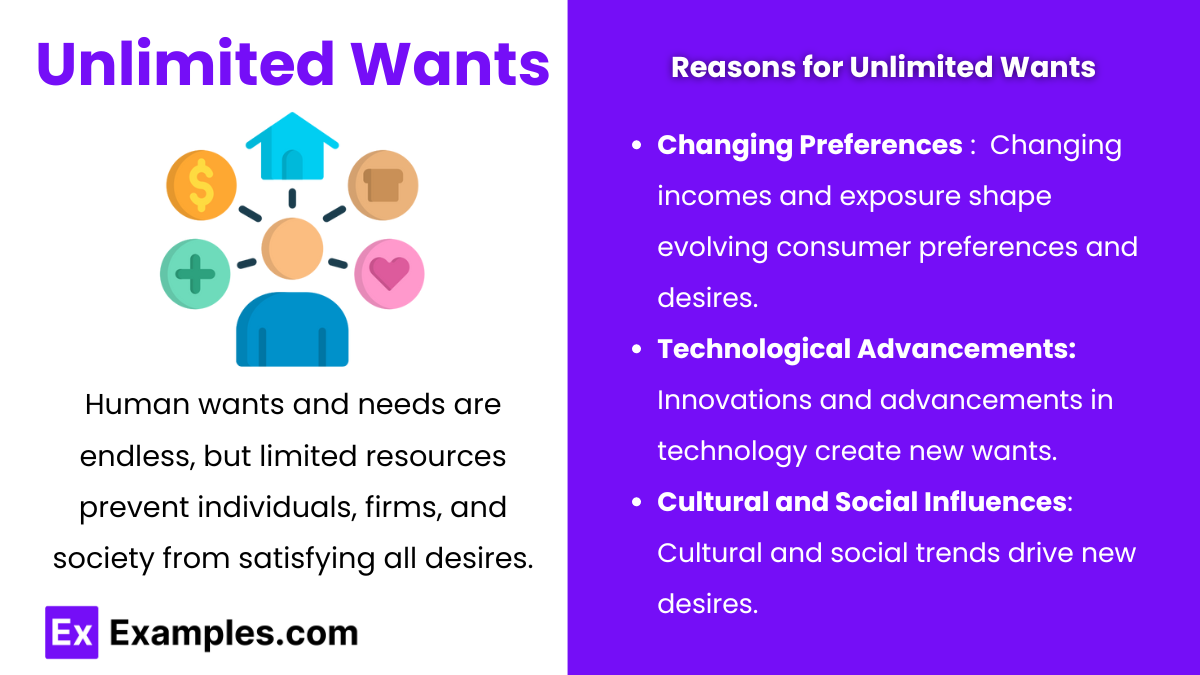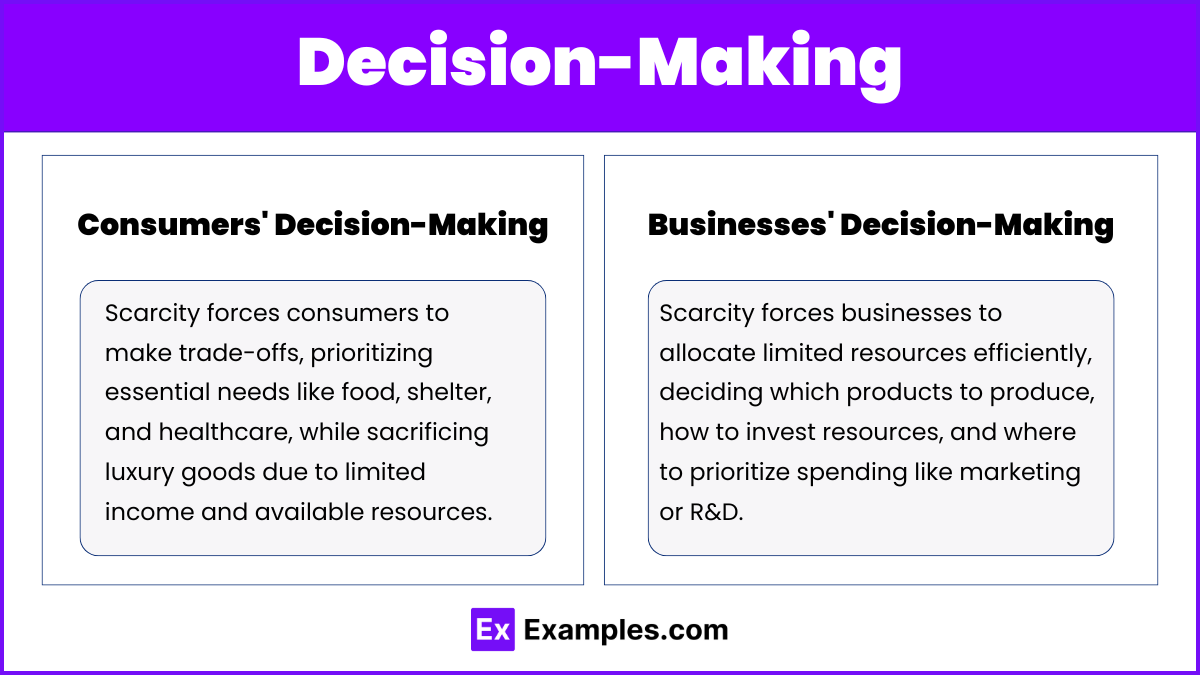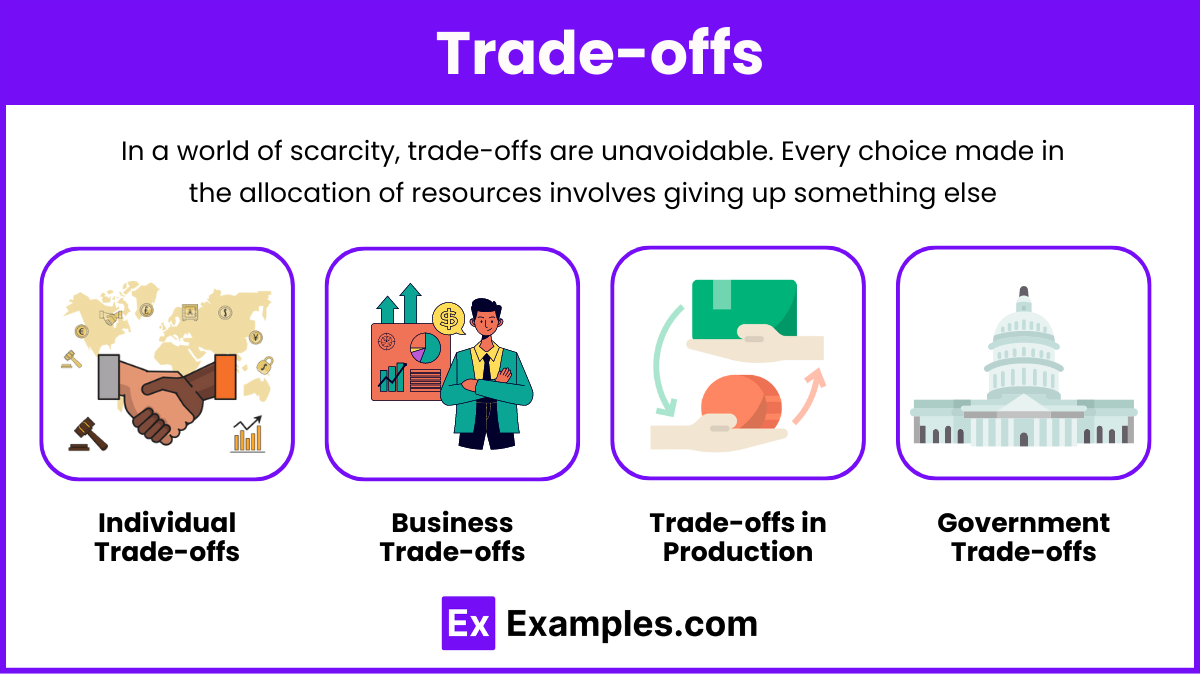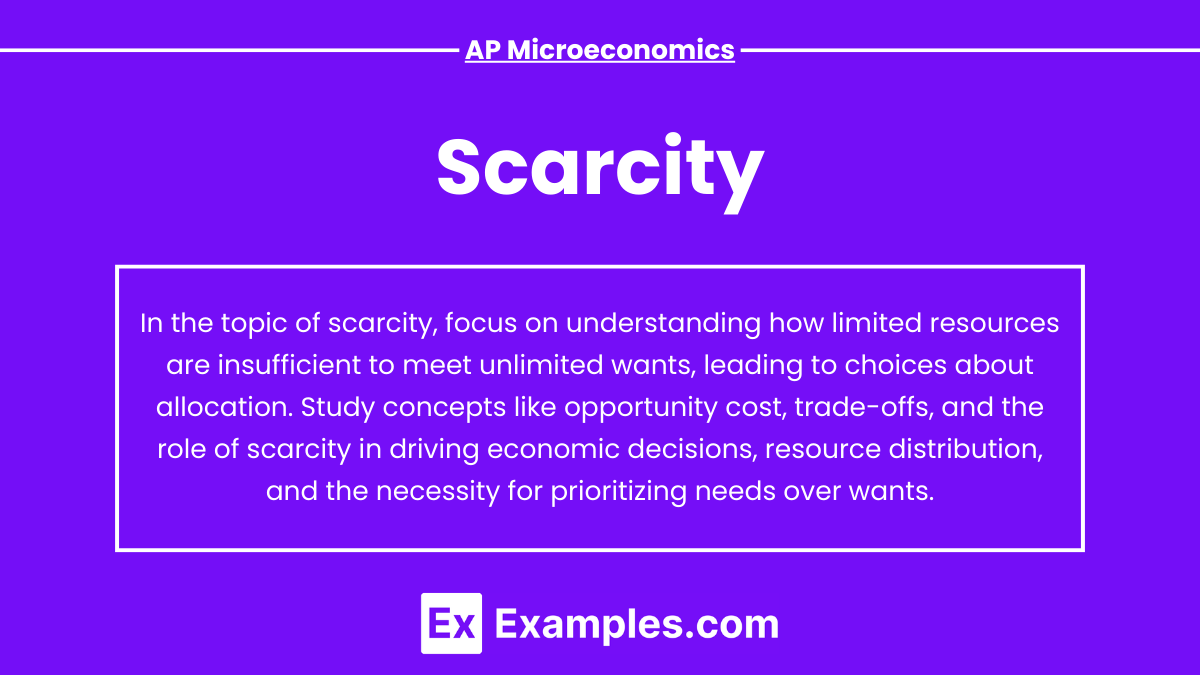In AP Microeconomics, scarcity is the core concept that drives economic decision-making. It refers to the limited availability of resources—such as land, labor, and capital—compared to the unlimited wants of individuals and businesses. Because resources are finite, individuals and firms must make choices, leading to trade-offs and opportunity costs. Scarcity forces society to prioritize how goods and services are produced and distributed, shaping the fundamentals of supply, demand, and pricing in microeconomic markets. Understanding scarcity is essential to analyzing economic behavior and market interactions.
Learning Objectives
In studying the concept of scarcity for AP Microeconomics, you should learn how limited resources and unlimited wants necessitate decision-making. Understand the role of opportunity cost and trade-offs in allocating resources. Analyze how scarcity affects consumer, producer, and government behavior, and how it leads to choices that maximize efficiency or equity. Additionally, focus on how prices serve as signals for resource allocation in markets and the balance between scarcity and economic outcomes like supply and demand.
“Scarcity” for AP Microeconomics
Scarcity is a fundamental concept in economics that applies to both microeconomics and macroeconomics. In microeconomics, scarcity refers to the limited availability of resources in relation to the unlimited wants and needs of individuals and firms. This mismatch forces individuals, businesses, and governments to make choices about how to allocate resources most efficiently.
Key Points
Limited Resources

Scarcity exists because resources such as land, labor, capital, and entrepreneurship are finite. These resources are necessary for the production of goods and services but are always in limited supply.
- Land: Refers to all natural resources, including minerals, water, forests, and land itself. These resources are non-renewable or take long periods to replenish, making them inherently scarce. For example, oil and clean water are essential for many industries, but their limited supply restricts production and increases competition for access.
- Labor: Represents human effort used in the production of goods and services. The availability of skilled labor is limited by factors such as education, population growth, and migration. In many economies, a shortage of qualified workers in certain industries, like technology or healthcare, highlights how the scarcity of labor can impact economic growth and productivity.
- Capital: Refers to the tools, machinery, and technology used in the production process. Capital is created by human effort and investment, but its availability is limited by financial resources and technological advancements. For instance, not all countries or businesses have access to advanced machinery, which limits their ability to compete on a global scale.
Unlimited Wants

Human wants and needs are virtually infinite. Individuals, firms, and society continually desire more goods and services, which cannot be fully satisfied due to limited resources.
Reasons for Unlimited Wants:
- Changing Preferences: Human desires are not static. As people’s incomes rise and their exposure to new products and services grows, their preferences evolve. For instance, what was once considered a luxury, like smartphones or international travel, can become a necessity over time.
- Technological Advancements: Innovations and advancements in technology create new wants. For example, the invention of the internet has led to a demand for online services, cloud storage, and smart devices, none of which were previously part of human wants.
- Cultural and Social Influences: Cultural and social trends drive new desires. Advertising, social media, and peer influence shape consumer preferences and create a constant craving for newer or trendier goods and services.
Opportunity Cost
Because of scarcity, every choice comes with an opportunity cost. Opportunity cost is the value of the next best alternative forgone when a decision is made. For instance, if a company chooses to produce more computers, it might produce fewer cars, as the resources devoted to computers could have been used elsewhere.
Decision-Making

Scarcity forces individuals and businesses to make economic decisions. For consumers, scarcity means deciding what goods and services to purchase based on their limited budget. For businesses, it means determining how to allocate labor, capital, and raw materials to maximize profit.
- Consumers’ Decision-Making:
For consumers, scarcity creates the need to make trade-offs when spending their limited income. They must weigh the benefits of purchasing one good or service against another, prioritizing essentials like food, shelter, and healthcare, while potentially foregoing luxury items. - Businesses’ Decision-Making:
For businesses, scarcity affects how they allocate their limited resources—labor, capital, and raw materials. Firms must decide which products or services to produce, how much of each resource to invest, and where to allocate funds (such as marketing or research and development).
Trade-offs

In a world of scarcity, trade-offs are unavoidable. Every choice made in the allocation of resources involves giving up something else. These trade-offs are a core element of supply and demand decisions in microeconomics.
- Individual Trade-offs: Consumers face trade-offs in their daily decisions. For example, when a consumer chooses to spend money on a new phone, they forgo the opportunity to use that money for other things, such as saving for the future or purchasing other goods. This is the essence of opportunity cost—the cost of choosing one alternative over another.
- Business Trade-offs: Firms must also make trade-offs. A business that chooses to invest in new machinery might have to delay hiring additional employees or expanding its product line. Businesses must weigh the costs and benefits of each decision, considering which option will maximize their profits given their limited resources.
- Trade-offs in Production: Trade-offs occur in the production process when firms decide how to allocate factors of production, such as land, labor, and capital. For instance, a car manufacturer may decide to produce more SUVs, which means producing fewer sedans due to limitations in factory capacity and raw materials. This trade-off reflects the principle that increasing the production of one good reduces the ability to produce other goods.
- Government Trade-offs: Governments also face trade-offs in how they allocate their budget. For example, increasing spending on healthcare might require reducing spending on education or infrastructure. These decisions reflect the limited financial resources available to governments and the need to prioritize between competing social objectives.
Resource Allocation
Scarcity also affects how resources are allocated across the economy. In a market system, prices play a critical role in this process by signaling how scarce a resource is. Higher prices typically indicate greater scarcity, prompting suppliers to produce more of that good or service.
Examples
Example 1: Labor Shortages in a Specific Industry
In certain industries, skilled labor may be scarce. For example, in the tech industry, there may be a limited number of qualified software developers. This scarcity of labor forces firms to make trade-offs, such as paying higher wages to attract talent or investing in employee training programs, thereby incurring higher opportunity costs in other areas like research or expansion.
Example 2: Scarcity of Natural Resources
A common example of scarcity is the limited availability of natural resources such as oil. Oil is a finite resource, and as demand for fuel and energy increases globally, the scarcity becomes more evident. This forces companies and countries to make decisions about how to allocate oil, whether to focus on immediate consumption, investment in alternative energy sources, or stockpiling for future use.
Example 3: Land Scarcity in Urban Areas
In densely populated cities, land for housing and commercial development is scarce. With a fixed amount of land and growing demand for space, prices of real estate increase. Scarcity forces businesses and individuals to make choices about how land should be used — whether for housing, commercial ventures, or public spaces — often leading to trade-offs between competing needs.
Example 4: Limited Availability of Capital for Startups
Startups often face scarcity in terms of financial capital. Venture capital and other funding sources are limited, and entrepreneurs must decide how to allocate their limited resources efficiently. They must choose between investing in product development, marketing, or expanding operations, each decision involving an opportunity cost where another area is sacrificed.
Example 5: Scarcity of Healthcare Resources
Healthcare resources, such as doctors, hospital beds, and medical equipment, are often scarce, particularly in times of crisis like a pandemic. As a result, hospitals and healthcare systems must make difficult choices about how to allocate these resources. For example, they might prioritize urgent cases over elective procedures, leading to trade-offs that affect both healthcare outcomes and economic decisions within the industry.
Multiple Choice Questions
Question 1
What is the best definition of scarcity in economics?
A) The unlimited supply of goods and services
B) The shortage of certain products in a market
C) The inability of society to satisfy all human wants due to limited resources
D) The availability of substitutes for goods and services
Answer: C
Explanation: Scarcity in economics refers to the fundamental problem that arises because resources (such as land, labor, and capital) are limited, but human wants are unlimited. This forces individuals, firms, and governments to make decisions about how to allocate these finite resources efficiently. Option C reflects the core economic concept of scarcity, while the other choices either ignore the idea of limited resources or misinterpret scarcity as a simple market shortage.
Question 2
Which of the following best describes the relationship between scarcity and opportunity cost?
A) Scarcity causes individuals to avoid making choices
B) Scarcity means that opportunity cost is zero
C) Scarcity forces individuals to make trade-offs, leading to opportunity costs
D) Scarcity allows for an unlimited number of choices without consequences
Answer: C
Explanation: Scarcity forces people to make decisions about how to use their limited resources. When a decision is made, the next best alternative that is forgone is referred to as the opportunity cost. For example, if you spend money on a concert ticket, the opportunity cost could be the dinner you could have had instead. Option C correctly captures the relationship between scarcity and opportunity cost, emphasizing the trade-offs required in decision-making.
Question 3
Why is scarcity considered a fundamental problem in microeconomics?
A) It forces governments to intervene in markets
B) It only affects poor economies with fewer resources
C) It necessitates the allocation of limited resources to satisfy competing wants
D) It allows for the creation of unlimited goods and services
Answer: C
Explanation: Scarcity is the central problem that economics seeks to address. Since resources are limited but human wants are infinite, scarcity forces individuals, businesses, and governments to make choices about how to allocate those resources. Microeconomics specifically studies how markets and individual decision-makers respond to scarcity. Option C correctly reflects this economic principle, while the other answers either misinterpret scarcity or ignore its universality.


